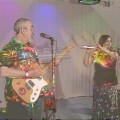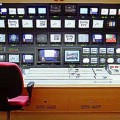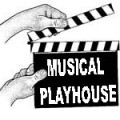(Jay Allen Sanford tunes into San Diego music on the public airwaves.)
 One of the many things we can either thank or curse the U.S. Congress for is public-access television. In the 1970s, as TV cable companies were growing into regional monopolies, Congress mandated that larger cable providers must put aside channels for public-produced community programming.
One of the many things we can either thank or curse the U.S. Congress for is public-access television. In the 1970s, as TV cable companies were growing into regional monopolies, Congress mandated that larger cable providers must put aside channels for public-produced community programming.
Today, there are over a thousand public access TV stations operating nationwide. When the city of San Diego grants charters to cable giants like Cox and Time-Warner, those companies guarantee this access to the airwaves, training (at no charge) interested community residents to run the equipment and to shoot and produce their own programs.
These shows can be on virtually any subject, provided certain technical procedures are followed and community standards are not violated. Public access producers operate under three basic guidelines — no soliciting of funds; no lotteries; and no obscenities, either verbal or visual.
Other than that, pretty much anything goes, and this sometimes results in controversies such as when the Ku Klux Klan began producing its own shows for local cable.
In San Diego, this do-it-yourself programming can be seen at various hours on Cox Channel 24 (Channel 18 in North County) and Time-Warner channel 15. Saturday Night Live’s “Wayne’s World” and “Goth Talk,” while ostensibly parodies of public-access TV, are not too dissimilar from the musical fare which has appeared on local-access stations.
Channel surfers used to find great amusement at the metalhead antics on “Music Underground,” where goofy local longhairs tried to say something intelligent (rarely succeeding) between bottom-of-the-barrel music videos, murky sub-bootleg concert footage and manic interview clips.
Club 33 on Cox captured early ‘80s performances by the likes of Manual Scan; NE1; and a memorable Beat Farmers set at the El Cajon Cox studio where Country Dick Montana refused to abide by the “No drinks on the set” rule, pulling beer bottles from his coat every few moments, only to have studio techs keep taking the bottles away from him, on camera, as the band continued to play.
Manual Scan plays “New Difference” on Club 33 circa 1984
Several Christian rock shows have come and gone on local access over the past few years, plus there’s “Yourself Presents,” which featured bands taped live at Cox’s TV studio, playing along with trippy ‘60s graphics and occasionally being interviewed by one of the show’s hosts, a musical couple who also ran the local branch of marijuana enthusiasts behind NORML.
Beginning in 1988, “Yourself Presents” ran for over two decades, with each ep usually featuring the host duo Howard and Diane Anshell performing (him on guitar, her on flute and Ono-esque vocals), as they had on local stages for the previous 10 years. Acts that performed live on the Cox Cable soundstage in El Cajon behind Parkway Plaza included Collage Menage; Deadbolt; Tomcat Courtney; Bratz; Joe Rathburn; Sneaker Kings; Fish and the Seaweeds; Nimbus Obi; Len Rainey and the Midnight Players; and well over a hundred others, including occasional karaoke acts and, on one memorable/hallucinogenic special, puppet marionette versions of the host duo (?!).
Gunther’s Grass on Yourself Presents
Dimension Cable used to run its own rock show, “Dimension Video Explosion,” and local music booster Brad Cahill paid his own expenses to produce an adventurous but now-defunct program called “Songwriter Spotlight.”
In the late ‘80s, North County cable networks hosted an access jazz show called “Music of Life.” In 1993, the local program “Hot Traxx,” produced by David Law, earned accolades for showing R&B and urban rap videos and was actually cited as one of the best regional music video shows at that year’s Billboard Music Video Awards.
"Leche — The Musical”
Jason Bang, currently a local stand-up comedian, used to produce a public-access TV program called "Leche — The Musical," which aired on Oceanside’s KOCT from early 1993 through early 1995.
 “The show was a who’s who of the early-to-mid-‘90 local music scene,” says Bang. Each 30-minute episode was shot at venues like Soma (“Len Paul was always fine with me shooting, provided the band was good”); the Casbah (“Tim Mays was always nice”); Bodie’s; and the Worldbeat Center.
“The show was a who’s who of the early-to-mid-‘90 local music scene,” says Bang. Each 30-minute episode was shot at venues like Soma (“Len Paul was always fine with me shooting, provided the band was good”); the Casbah (“Tim Mays was always nice”); Bodie’s; and the Worldbeat Center.
“I even shot interviews on the streets of the Gaslamp, at Cargo Records HQ, and at the Independent Music Seminar in ‘93 or ‘94. We taped live footage of Tanner, Drive Like Jehu, Inch, Deadbolt, Heavy Vegetable, Three Mile Pilot, aMiniature, Swivelneck, Creedle, Boilermaker, Rust and Uncle Joe's Big Ol’ Driver.”
He recalls “Since it was public access, we had to work with the crappiest and most unreliable equipment imaginable. … It came to a halt when KOCT decided it could no longer fund that area of public access.” A possible DVD compilation is in discussion.
“We taped footage of one of Powerdresser’s last shows with Denver Lucas in 1994,” says Bang, “and I shot the final video interview with him before he disappeared.” Lucas was last seen alive by roommates on November 2, 1994, allegedly high on LSD and heading for the cliffs of Encinitas. His badly decomposed body was discovered over a week later off Carlsbad Beach and originally listed as a “John Doe” until fingerprints were matched to musical instruments in his home.
“During the interview, he admitted to doing drugs, mushrooms, acid and any other hallucinogenic drugs that he felt like doing. He also put across a message of love. He said, ‘If you're with someone that you love, tell them now while you have the chance.’ Before he passed away, he agreed to do a bit in the TV show called ‘Dear Denver,’ where he’d answer letters about love and life to anyone that wrote in.”
“Musical Playhouse”
 Another San Diego public-access show, “Musical Playhouse,” was cited in 1993 for excellence by the Western States Region Of The Alliance For Community Media. Produced by Pat Samms and then airing on Cox Cable, Musical Playhouse has continued running off and on, featuring local and national music videos, interviews and public-service announcements.
Another San Diego public-access show, “Musical Playhouse,” was cited in 1993 for excellence by the Western States Region Of The Alliance For Community Media. Produced by Pat Samms and then airing on Cox Cable, Musical Playhouse has continued running off and on, featuring local and national music videos, interviews and public-service announcements.
Samms herself is not a musician, but she’s a longtime supporter of the local music scene. In addition to producing her TV show, she sometimes books and promotes various acts and events. She says she has a medical background and has studied law, though the latter is a mostly self-taught discipline.
“I did legal research in order to file a lawsuit against the owners of an apartment complex I lived in, in Rancho Peñasquitos. There were gang members living underneath me, and I have kids. They’d make so much noise, my floor was vibrating like an earthquake all hours of the night.”
She says she tried to get the gangster neighbors evicted. “But then I ended up being evicted myself because management was friends with them (the gang members).” She went to court to fight the eviction and ended up being allowed to stay.
Samms spent around 10 years maintaining a low-key involvement with San Diego bands and venues, operating below the radar so successfully that she feels she doesn’t always get credit for things she’s done. “Remember in 1993 or 1994 when Park Place [in El Cajon] started having original bands there? I started that for them, but I didn’t have a contract. I did it for awhile and it went so well, it went from like three people on a Sunday night to 200. But I didn’t get anything in writing, and so [another promoter] saw this great opportunity and they took it over.”
Before launching “Musical Playhouse,” Samms volunteered to work on other producers' public access shows, just to get experience with the equipment and to find crew people she could tap for her own video productions. Then she videotaped local events like Artwalk and put together her own documentary about the homeless in San Diego.
“For the first episode of ‘Musical Playhouse,’ we had Catch 22 as the first band to play on the show. The lead singer unfortunately died of AIDS a few years ago. They were great, they even shot a video just for the troops fighting in the Gulf War that we aired. We had The Psycho Rangers and all kinds of bands that were big back then.”
Her early shows were shot in the studio, though she soon began going out on location as well. “Once I’d done a few interviews with major acts, record companies and promoters were calling me with more offers and contacts. Finding acts to feature wasn’t that hard because who doesn’t want TV exposure?”
Have gear, will travel
The programs are usually shot on Cox's bulky, well-used ¾-inch video equipment, which is shared by all local producers and which often malfunctions. "Either myself or one of my crewpeople, sometime we have to rig up cameras, recorders, mics and lights with wires, super glue, duct tape or whatever it takes to keep things running.”
With limited studio time available and long lines of producers awaiting access, they usually shoot the bands playing live with no rehearsal. “I’ll be behind the camera and this is the first time I’ve even heard the song, these songs aren’t on the radio. So I just get right there on that instrument or on the singer, all on the fly and try to go along with the music.”
Samms has done on-camera interviews with performers like Mick Fleetwood, Candlebox and others. Recalling when she was scheduled to videotape an interview with Cheap Trick at the short-lived Coach House San Diego off Friar’s Road, she says “When we got there, the room wasn’t even big enough to fit us all, so we moved out into the back alley to tape. It’s not easy to light a dark alley, and it's sure not the ideal atmosphere to conduct an interview.”
Other risky environments, both for Samms and the equipment (for which she's fully and financially responsible) are live concerts, such as Rick Derringer at Adams Avenue Street Fair and The Fabulous Thunderbirds. “Especially when they have a mosh pit and I'm trying to tape. People don’t care, they’ll bump into you and smash stuff. Like at The Scorpions and Alice Cooper, you can see the camera jiggling — we almost lost it a few times. I just stand my ground, though.”
“It’s hard at The Belly Up too, it gets a little rowdy up front. I have to have another person standing behind me, especially if I want to bend over and do something so I don’t get knocked over.”
The music focus of the show requires special consideration toward sound recording, even when she’s just conducting interviews with band members backstage. “We’re going to interview Kansas right before they go onstage. In the back room at 4th & B, they’re doing the sound check right there, and you can hear everything. I’ve got to have a handheld mic and a boom mic that can pinpoint us talking and not catch all the other sound.”
In the studio, she relies on sound techs to advise her, and she says it helps that bands often bring their own microphones and mixing boards which she can plug into her own sound channel.
Even with a rotating crew of temporary helpers, Samms says “Musical Playhouse” is still basically a one-woman operation. “People really frown on that, but you know what? I know it sounds weird but I have a deep voice and when people first hear me on the phone they think I’m a guy so they say 'yes.' They’re far more agreeable if they think it’s a guy. But when they meet me in-person, their mouths drop to the ground! Believe it or not, it is harder for a woman than a man in this business. Some of the bands especially treat me different; it’s very chauvinistic. It gets me riled a little bit but that just makes me work harder.”
And few realize just how much work it takes to keep a TV show running for nearly 10 years, Samms says. "Just from a technical standpoint, the rules at Cox are pretty restrictive. You have to have the right amount of color bars and slate. The audio track has to be on Channel Two only. The program has to run 29 minutes and 30 seconds, no longer. If you go another 30 seconds, they don’t air it.”
“You used to be able to put two shows on a tape (and the tapes are really expensive!) but not any more. You have to have six tapes in the can for a show before they’ll run any of the episodes.”
Over 60 episodes of “Musical Playhouse” were shot and aired, most of them produced for and aired on Cox's local access station. The show was nominated for a cable W.A.V.E. award, given to outstanding public-access programs (“That’s not an oxymoron”) produced in Nevada, California and Hawaii.
“I was beat out by a comedy show,” she notes dryly.
Many of her interviews with national acts haven’t even aired on the show yet. Asked why not, she says “I’d like to put them on pay TV [leased access], where you can have commercials. Public access, you can’t have commercials, and you can’t make money. My people should be paid; they do excellent work.”
The interviews, however, were mostly shot using Cox’s video equipment, and Cox's public-access agreement forbids for-profit endeavors, so how can the shows be used to generate income? “Cox used to be better about things like that. Originally, if my show had a sponsor, or someone like Guitar Trader donated some mics, we could list their name and phone number and maybe a web address in the credits.”
“Now it’s to the point where you can mention their name only. They don’t allow anyone to do anything at all commercial. But they [Cox] support what I do, and they'll probably want to keep showing [“Musical Playhouse,”] so I don't think they mind me promoting it to a national audience.”
She’s had disputes with Cox over the program which date back to the earliest days in 1993, and not just over commercial considerations. “One of the videos we shot was of the band Psycho Rangers playing, and they had a girl dancing who had a bikini on. She had a suit coat over it but the coat was open. I found out my show was in the hands of Cox’s attorneys, and that they refused to air it.” She says there was nothing wrong with the video.
“They [Cox] thought it was obscene pornography ... I was raising four kids at the time, I’m not going to put anything obscene on TV. Then what happened was they had way over 50 phone calls from people wanting to see that show. The Public Access Supervisor actually had his family’s lives threatened because they didn’t want to air [the video].”
How did the callers even know the video existed, if it had never aired? “Because of the band’s following, they told their fans. And then word got around, and everyone called. They ended up airing it.”
Outside of rare content issues like this, Samms says Cox pays little attention to what goes on with its local programming department. “It’s been that way for a long time. I don’t think they care, because it’s public access.”
She says the cable company’s technicians don’t even bother to sync up the color or sound on many of her shows as they air. She's ceased production several times for different reasons and varying lengths of time, including once due to a long recuperation from a car accident. "I'm putting together some specials now, using some of the interviews with national acts, and I'll definitely be shooting some new episodes sometime soon.”
“I also want to promote local shows and bands and I’m looking for a venue,” Samms says. “And if I could find the right local group, I’d like to manage them and help them with the legal side of things, signing contracts and publishing deals, so there’s always a new project that’s somehow connected back to the TV show.”
“I’m even getting referrals to shoot video at weddings. … That never would have happened, if it weren’t for the [public-access] show.”
— Jay Allen Sanford
More by Jay Allen Sanford: